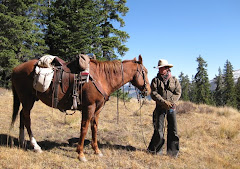
We are blessed to live adjacent to the Weminuche Wilderness. Yes, that’s Wilderness with a capital W. A designated location, almost a half a million acres of what we otherwise may find a more productive use for. There is little value in peace and solitude. Can you place a price tag on “wild?” What is the value of the wild, except something deep and dark within us all? Something we often prefer to overlook.
Out here, out this far, there are fewer willing to find this place, find that space within themselves. As outfitters, we see that business is less and less in the back country. Far away is even further. Being out of touch is out of mind. Uncomfortable is not a chosen state. So fewer come. Beyond the trailheads easy to the masses to access, there is a reduction of use, especially in use beyond a short day’s hike.
Why should we care? I once received the response, “Gee, great, more for me.” That’s not the answer I hoped to hear.
Why aren’t we out there enjoying the wild more? Why don’t we care? Have we forgotten what it feels like, and what it can do for us deep down inside, and what it really means in the big picture?
Us back country users/enjoyers are getting greyer, and the younger generations aren’t going out there. Why not? If we can blame someone, do we blame ourselves, the parents and elders, who don’t make the time to take the kids on a pack trip, a camping weekend, or even a long Sunday hike? If they aren’t given the chance to be out there, how will they learn to appreciate the wild? How will they ever know how incredible it feels, smells, sounds, looks? There are some things that can not be replaced by the TV, the Game Boy, and Instant Messenger. Are we teaching our kids to sit and listen to stories, to walk in nature, to stop and listen and look and feel the beauty of the world around them? Is it too late?
Years ago, I was lucky enough to have the opportunity to take small groups of kids from a summer camp out on pack trips. I truly believe each and every child who participated was touched in a way that would effect them forever – touched by nature, by wildlife, by the responsibility of caring for their horse and in turn, trusting the horse to care for them, by the camaraderie of such simple but true friendships that are built around camp fires and out gathering horses in the early morning dew. I wish more kids could have this experience. Children’s camp like that is usually limited in its scope and available only to an “elite few,” but as Forrest says, at least we had the chance to open this world up to those few.
Much of my outfitting work now is day rides with people who have never been on horse, or at least, never taught how to be on a horse. I am given the opportunity to share this with my guests, and then take them out to show them something even more: the mountains and trails and wild places all around us. Still, every time I take riders out, I am so excited when I return and tell Bob all about how wonderful this person did, how I watched him or her do so well with their horse, what a beautiful time I know they had, and most important, how special a day I was able to provide for them, what a world out there they got to experience that they didn’t know existed before that ride, or at least forgot, and needed this simple time in the saddle out there to remember. And yet, still, they remained so close to the comfort of the ranch, the road, the cabins. It is hard to venture far.
Less and less people know what it feels like. Being out in the wild just does something for a person. We touch the wild, and something wild within us stirs.
You know the old saying of “there is nothing better for the inside of a man than the outside of horse.” That’s a lot of it. But there’s more. There is nothing like waking in the morning to the crisp mountain air, and listening to the cow elk call her calf as you sit on the hillside and sip your coffee, to make you think about what really matters in this world. There is nothing like arriving at camp after a long day of hiking or in the saddle, and feel so at home, having “earned” your place relaxing by the campfire, to remind you of the simple pleasures in life. There’s nothing like seeing the stars out there, so far away, when you step away from the heat of the fire to feel your true place in this very big picture.
Nature is so important. And if we don’t use it, we could lose it. We will lose a part of ourselves if we forget or never know what it feels like. And we’ll risk losing the wild places. Will we then lose the wild part within us?
Man seems to feel that everything needs a purpose. If the purpose of the wilds is no longer valued for the irreplaceable goodness it provides for our body, mind and soul, then Man will probably put it to another use. Yes, our trails will be the first to go (we already have an ongoing struggle to keep them maintained). But then the wild places themselves may go – be sold off, sectioned off, a “better” use may be found.
I’m on my high horse here once again. OK, enough.
















